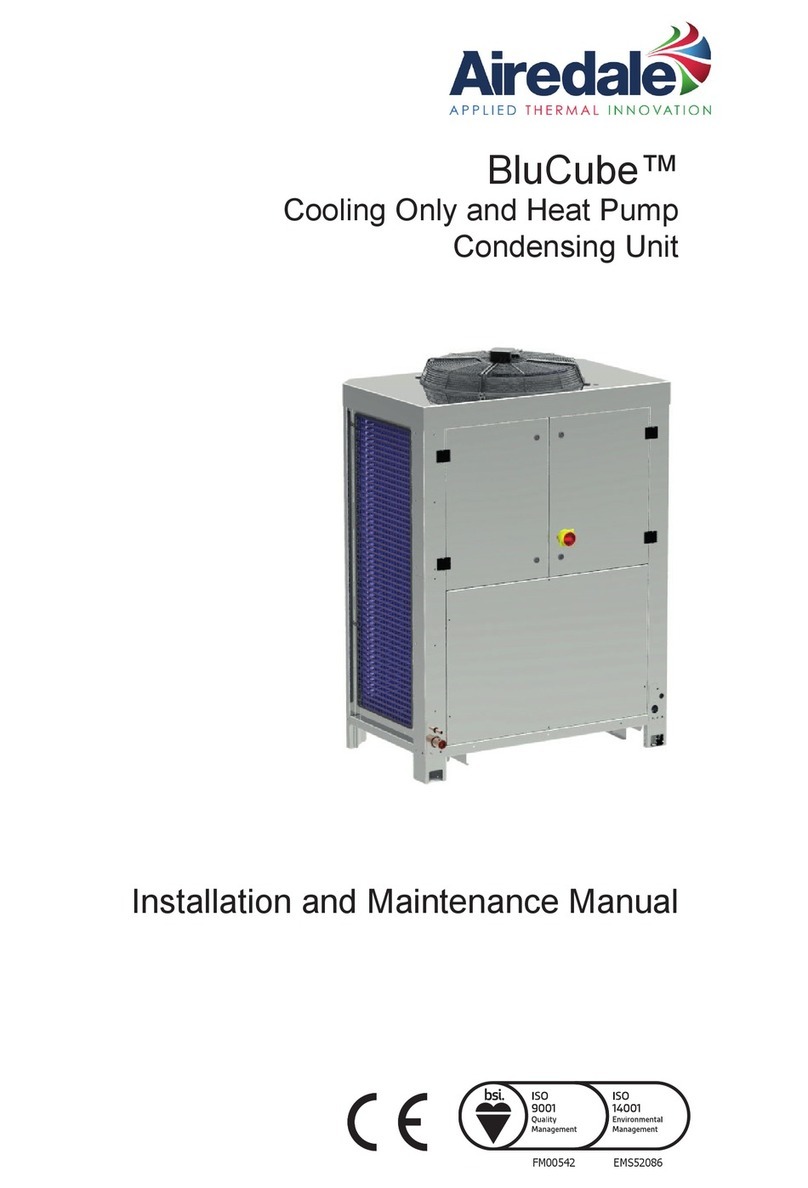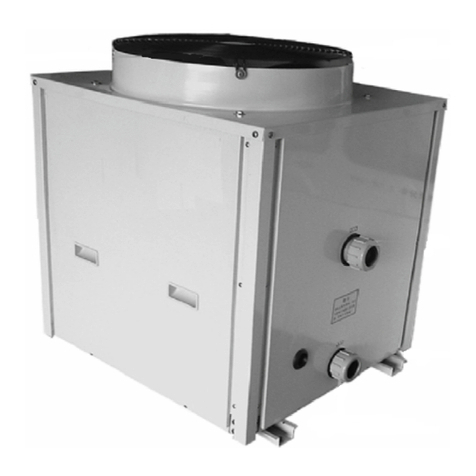
3
1. Please Read Immediately
1.1 Intended Use
1.3 Energy Efcient Use of the Heat Pump
1.4 Inspection of Equipment
1.5 Handling of the Unit
1.6 Unit Protection on Job Site
These devices are only intended for use as specied by the manufactur-
er. Any other use beyond that intended by the manufacturer is prohibited.
This requires the user to abide by the relevant project planning documents,
specications and installation and operating instructions. Please refrain
from tampering with or altering the device.
By operating this heat pump you are helping to protect our environment.
The heating system must be properly designed and dimensioned to
ensure efcient operation. It is particularly important to keep water ow
temperatures as low as possible in heating operation. All connected heat
emitters should therefore be suitable for low ow temperatures. Raising
the heating water temperature by 1.8°F (1°C) corresponds to an increase
in electric energy consumption of approx. 2.5%. Low temperature heating
systems with ow temperatures between 85°F and 125°F (30°C and 50°C)
are particularly well-suited for energy efcient operation.
Upon receipt of equipment, check the shipment against the packing slip
and the freight company bill of lading. Verify that all units and packages
have been received. Inspect the packaging of each unit for damages.
Any damage should be reported to the freight company immediately to
make sure they can not deny claims. Notify the wholesaler or party you
purchased this equipment from of any damages. It is the responsibility of
the purchaser to notify relevant parties and le the necessary claims with
the freight company.
The Heat Pump outdoor unit includes a TiltWatch® label on the packaging to
monitor if the unit has been tipped more than 45 degrees during shipment.
If this label has been activated, notify the freight company and contact Taco
customer service.
Do not clamp on the sides of either the HydroBox indoor unit or Heat Pump
outdoor unit when lifting or transporting the units into place. Damage can
occur to the panels of the units. Also take caution during transportation as
the outdoor unit may be top-heavy. Both units are too heavy for one person
to lift. It is highly recommended to install the HydroBox and heat pump with
two people. Use caution not to drop the units, which could cause damage
to the unit, property and/or sever personal injury.
Keep both units covered in the original packaging or equivalent
protective covering to protect the units from damage and contamination
due to paint spray, plastering or other airborne materials that may be
used during construction on the job site. This is especially important for
protecting the outdoor unit’s heat exchanger intake and outlet areas. All
piping connections should remain capped or recapped until the piping is
connected. Precautions must be taken to avoid physical damage and
contamination which may prevent proper start-up and may result in costly
repair or equipment failure.
Units should be transported and stored in an upright manner at all times
and should not be stacked. The HydroBox indoor unit cannot be stored
outside and should be protected from the elements during shipping. Excess
moisture can damage the electronics in the unit.
1.2 Legal Regulations and Directives
The heat pump is designed for use in a domestic environment according to
Article 1, Paragraph 2 k) of EC directive 2006/42/EC (machinery directive)
and is thus subject to the requirements of EU directive 2014/35/EU (low-
voltage directive). It is thus also intended for use by non-professionals for
heating shops, ofces and other similar working environments, agricultural
establishments and hotels, guesthouses and other residential buildings.
The construction and design of the heat pump complies with all relevant
EU and North American directives, including DIN, VDE, UL, FCC, and CSA
regulations.
When connecting the heat pump to the power supply, the relevant VDE, EN,
IEC, UL and CSA standards are to be adhered to. Any further connection
requirements stipulated by local utility companies or codes must also be
observed.
When connecting the heating system or cooling system, all country-specic
and local regulations must also be adhered to.
This unit can be used by children aged 8 and over and by persons with
limited physical, sensory or mental aptitude or lack of experience and/or
knowledge, providing they are supervised or have been instructed in the
safe use of the unit and understand the associated potential dangers.
Children must not play with the device. Cleaning and user maintenance
must not be carried out by children without supervision.
Warning! This heat pump system must be installed by a licensed
plumber, electrician, and/or professional service technician.
Improper installation and/or operation can cause a potentially
hazardous situation, which, if not avoided, could result in serious
injury or death, and will void the warranty.
Note: When operating or maintaining a heat pump, the legal
requirements of the state or country where the heat pump is operated
apply. Depending on the refrigerant ll quantity, the heat pump may have
to be inspected for leaks at regular intervals by a certied technician, and
these inspections must be recorded.
Note: No one but a professional service technician should attempt
to install, service, or repair this heat pump system. There are no
serviceable parts which can be changed by the user / owner. User /
owner should contact the original professional service technician if the
heat pump system needs repair or maintenance.
Note: When servicing the equipment, be sure to disconnect electrical
power before removing any of the panels from either the HydroBox indoor
unit or Heat Pump outdoor unit. There may be multiple disconnects for
each unit. Label all wires while performing service to ensure proper
re-wiring of the units. Wiring errors can cause improper or dangerous
operation. Failure to do so could result in an electrical shock, improper
heat pump operation, property damage, serious personal injury, or death.
Note: Do not use petroleum-based cleaning or sealing compounds in a
heat pump system. Gaskets and seals in the system could be damaged.
This could result in substantial property damage.
Note: Chemical imbalance of the water supply may effect efciency and
cause severe damage to the heat pump and associated equipment.
Water quality must be professionally analyzed to determine whether it
is necessary to adjust water quality. The water must be potable, free
of corrosive chemicals, sand, dirt, and other contaminates so as not to
damage the heat exchanger. Potable water is dened as drinkable water
supplied from a utility or well water in compliance with EPA secondary
maximum contaminant levels (40 CFR 143.3). Failure of the equipment
due to lime scale build-up or other chemical imbalance is not covered by
the warranty.
Note: Because water lines run between the HydroBox indoor unit and
Heat Pump outdoor unit, proper freeze protection may be required
depending on climate. Never use any toxic chemical, including
automotive, standard glycol antifreeze, or ethylene glycol made for
hydronic (non-potable) systems. These chemicals can attack gaskets
and seals in water systems, are poisonous if consumed, and can cause
personal injury.



























